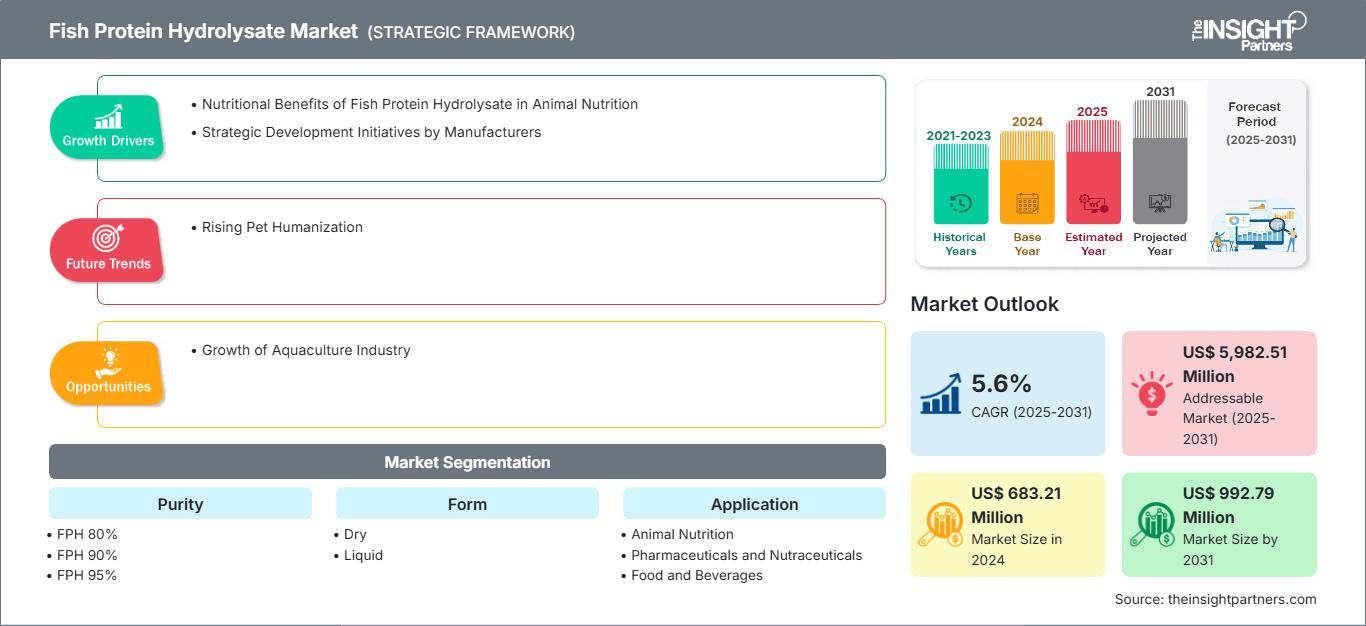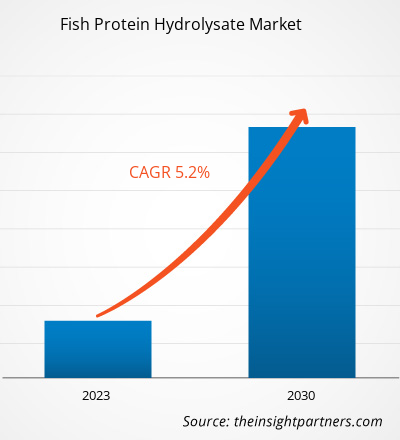预计到2031年,鱼类蛋白水解物市场规模将从2024年的6.8321亿美元增至9.9279亿美元。预计该市场在2025年至2031年期间的复合年增长率为5.6%。预计在预测期内,宠物人性化的兴起将在鱼类蛋白水解物市场中掀起新趋势。
鱼类蛋白水解物市场分析
鱼类蛋白水解物市场的发展得益于其在动物营养方面的优势以及主要参与者的各种战略发展。随着人们越来越意识到动物蛋白在宠物饮食中的营养价值,宠物食品行业对鱼类蛋白水解物 (FPH) 的需求不断增加。此外,由于对鱼类和海鲜的需求增加,水产养殖业的发展也推动了对鱼类蛋白水解物的需求。由于大量鱼类每年产生大量废弃物,这些废弃物经过加工后用于生产鱼蛋白水解物,从而推动了全球鱼蛋白水解物的市场增长。
鱼蛋白水解物市场概览
鱼蛋白水解物是一种营养丰富的产品,它通过酶促或化学方法将鱼蛋白分解成较小的肽和氨基酸,从而提高其消化率和生物利用度,可用于水产饲料、动物营养和农业。对可持续蛋白质来源日益增长的需求、水产养殖和畜牧业的增长以及人们对鱼蛋白营养益处日益增长的认识,推动了市场的增长。此外,水解技术的进步和政府对环保替代品的支持进一步推动了市场扩张。
自定义此报告以满足您的要求
您将免费获得任何报告的定制,包括本报告的部分内容,或国家级分析、Excel 数据包,以及为初创企业和大学提供超值优惠和折扣
鱼蛋白水解物市场: 战略洞察

-
获取本报告的主要市场趋势。这个免费样本将包括数据分析,从市场趋势到估计和预测。
鱼蛋白水解物的市场驱动力和机遇
鱼蛋白水解物在动物营养中的营养价值
鱼蛋白水解物富含蛋白质和磷、钙以及其他矿物质等营养物质。它能有效预防动物传染病的传播,并增强其对真菌、病毒、细菌和寄生虫的免疫力。经常食用鱼蛋白水解物有助于肉鸡的肌肉发育。鱼蛋白水解物中的酶有助于肉鸡消化纤维食物(包括谷物和豆粕),从而改善其肠道形态。
此外,鱼蛋白水解物因其丰富的蛋白质含量和适合水生动物的理想氨基酸平衡,被广泛用于水产饲料。鱼蛋白水解物还能增强动物的代谢系统,从而预防感染和疾病的风险。近年来,加工技术的发展也使得生产更高质量、更稳定的鱼蛋白水解物 (FPH) 原料成为可能。根据《食品工程杂志》2023年的一份报告,酶水解技术的进步以及鱼类副产品的可持续采购正在推动鱼蛋白水解物在商业饲料应用中的可扩展性。市场主要参与者正越来越多地利用这些技术创新来满足对清洁标签功能性动物饲料成分日益增长的需求。因此,与动物健康相关的鱼蛋白水解物的营养特性促进了其在动物饲料行业的需求。
水产养殖业的增长
鱼类胆固醇含量低,蛋白质含量高,导致全球对鱼类及其相关产品的需求不断增长。联合国粮食及农业组织 (FAO) 报告称,2022 年全球渔业产量达到 9230 万吨。
由于水产养殖产量的提高、文化偏好的转变以及对海鲜和鱼类需求的不断增长,渔业正在蓬勃发展。全球渔业数量的不断增长每年产生大量废弃物,估计占生物质的60%。渔业产生的废弃物经过进一步加工,用于生产鱼蛋白水解物。鱼类养殖是全球增长最快的食品生产领域之一,这为鱼蛋白水解物市场创造了巨大的增长机会。此外,鱼蛋白水解物广泛用于水产养殖饲料,以提高鱼类的成活率和生长率。鱼蛋白水解物还能促进许多养殖物种的免疫力和整体发育。氨基酸和鱼蛋白水解物肽的组成对各种鱼类的健康生长至关重要。许多水产饲料生产商正在积极添加促进健康的化合物,例如水解物、蛋白质和生物活性肽(包括鱼蛋白水解物),以采用有效的饲养方法。因此,预计不断发展的水产养殖业将在未来几年为鱼类蛋白水解物市场创造丰厚的利润。
鱼类蛋白水解物市场报告细分分析
促成鱼类蛋白水解物市场分析的关键细分市场是纯度、形态和应用。
- 根据纯度,全球鱼类蛋白水解物市场细分为FPH 80%、FPH 90%、FPH 95%和其他。预计FPH 80%细分市场在预测期内的复合年增长率最快。
- 就形态而言,市场细分为干型和液态。2024年,干型细分市场占据了鱼类蛋白水解物市场的最大份额。
- 就应用而言,市场细分为动物营养、药品和营养保健品、食品和饮料、个人护理和农业。动物营养细分市场进一步细分为家禽、水产养殖、猪、反刍动物、宠物食品等。动物营养细分市场在2024年占据了鱼类蛋白水解物市场的最大份额。
按地区划分的鱼类蛋白水解物市场份额分析
鱼类蛋白水解物市场报告的地理范围分为五个区域:北美、亚太地区、欧洲、中东和非洲以及南美和中美洲。亚太地区在2024年占据了鱼类蛋白水解物市场的主导地位,这得益于其占主导地位的水产养殖和渔业部门,该部门提供了丰富的原材料,例如鱼类副产品和水解边角料。中国、印度、越南和印度尼西亚等国家为该地区的水产养殖生产做出了贡献,推动了对成本效益高、营养丰富的饲料添加剂(例如FPH)的需求,以促进鱼类生长和增强抗病能力。此外,海产品消费量的不断增长、政府对可持续水产养殖实践的支持,以及通过增值加工减少渔业废弃物的需求,进一步推动了亚太地区鱼蛋白水解物的采用。该地区的大型畜禽养殖业也将鱼蛋白水解物用作蛋白质补充剂,而人们对其在动物营养方面的健康益处的认识不断提高,也加速了市场的增长。此外,该地区水解技术的进步和对鱼类加工基础设施的不断投资增强了生产能力。亚太地区注重循环经济原则和高效的资源利用,在人口增长、蛋白质需求和蓬勃发展的饲料行业的支持下,仍然是鱼蛋白水解物生产和消费的关键中心。
鱼蛋白水解物市场
鱼蛋白水解物市场
The Insight Partners 的分析师已详尽阐述了预测期内影响鱼类蛋白水解物市场的区域趋势和因素。本节还讨论了北美、欧洲、亚太地区、中东和非洲以及南美和中美洲的鱼类蛋白水解物市场细分和地域分布。
鱼蛋白水解物市场报告范围
| 报告属性 | 细节 |
|---|---|
| 市场规模 2024 | US$ 683.21 Million |
| 市场规模 2031 | US$ 992.79 Million |
| 全球复合年增长率 (2025 - 2031) | 5.6% |
| 历史数据 | 2021-2023 |
| 预测期 | 2025-2031 |
| 涵盖的领域 |
By 纯度
|
| 覆盖地区和国家 |
北美
|
| 市场领导者和主要公司简介 |
|
鱼蛋白水解物市场参与者密度:了解其对业务动态的影响
鱼类蛋白水解物市场正在快速增长,这得益于终端用户需求的不断增长,而这些需求的驱动因素包括消费者偏好的演变、技术进步以及对产品益处的认知度的提升。随着需求的增长,企业正在扩展产品线,不断创新以满足消费者需求,并抓住新兴趋势,从而进一步推动市场增长。

- 获取 鱼蛋白水解物市场 主要参与者概述
鱼蛋白水解物市场新闻及最新动态
鱼蛋白水解物市场评估通过收集主要和次要研究后的定性和定量数据进行,这些数据包括重要的公司出版物、协会数据和数据库。鱼蛋白水解物市场的一些关键发展如下:
- 帝斯曼-芬美意宣布在北美推出Life's OMEGA O3020,这是首款也是唯一一款单一来源的藻类Omega-3,其二十碳五烯酸 (EPA) 与二十二碳六烯酸 (DHA) 的比例与标准鱼油中的天然比例相同,但效力却是后者的两倍。(来源:帝斯曼-芬美意,新闻稿,2023年10月)
- Coromega 宣布推出 Coromega Max Gold,这是一款先进的高浓度 Omega-3 鱼油补充剂,旨在让每一剂都能带来最大的健康益处。 (来源:Coromega,新闻稿,2024 年 12 月)
鱼类蛋白水解物市场报告覆盖范围和可交付成果
《鱼类蛋白水解物市场规模和预测(2021-2031)》报告对市场进行了详细的分析,涵盖以下领域:
- 涵盖范围内所有主要细分市场的全球、区域和国家/地区鱼类蛋白水解物市场规模和预测
- 鱼类蛋白水解物市场趋势,以及市场动态,例如驱动因素、限制因素和关键机遇
- 详细的波特五力模型和 SWOT 分析
- 鱼类蛋白水解物市场分析,涵盖主要市场趋势、全球和区域框架、主要参与者、法规和最新市场发展
- 行业格局和竞争分析,涵盖市场集中度、热图分析、知名参与者和鱼类蛋白水解物的最新发展市场
- 详细的公司简介
- 历史分析(2 年)、基准年、预测(7 年)及复合年增长率
- PEST和SWOT分析
- 市场规模、价值/数量 - 全球、区域、国家
- 行业和竞争格局
- Excel 数据集
近期报告
相关报告
客户评价
购买理由
- 明智的决策
- 了解市场动态
- 竞争分析
- 客户洞察
- 市场预测
- 风险规避
- 战略规划
- 投资论证
- 识别新兴市场
- 优化营销策略
- 提升运营效率
- 顺应监管趋势






















 获取免费样品 - 鱼蛋白水解物市场
获取免费样品 - 鱼蛋白水解物市场